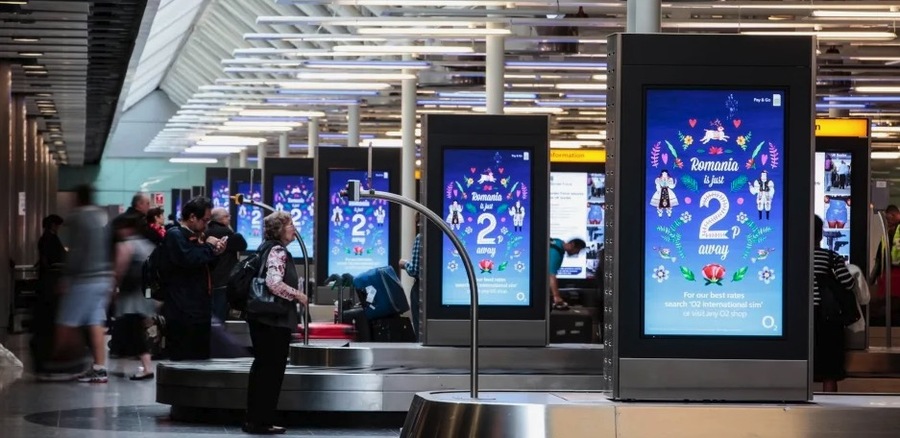Digital signage refers to the use of digital displays, such as LCD, LED, or projection, to convey information, advertisements, and other content to a target audience. These displays can be found in various locations, including retail stores, transportation hubs, corporate offices, healthcare facilities, and more. The primary uses of digital signage include advertising, wayfinding, public information dissemination, and enhancing customer experiences through engaging visual content.
Importance of Real-Time Data
Real-time data is crucial for businesses and organizations as it allows for immediate decision-making and responsiveness to changing conditions. By leveraging real-time data, companies can enhance operational efficiency, improve customer satisfaction, and gain competitive advantages. For example, studies show that businesses using real-time data can improve operational efficiency by up to 25% and increase customer satisfaction by 30%.
History and Evolution of Digital Signage
Early Beginnings
Digital signage began with simple electronic displays in the 1960s and 1970s that were primarily used for basic information sharing, such as scrolling text displays in public places. These early signs were static and limited in their functionality, serving primarily as electronic versions of traditional posters and billboards.
Technological Advances
The evolution of digital signage has been driven by advancements in display technology, networking, and software. Innovations such as high-definition screens in the 1990s, touch interfaces in the early 2000s, and content management systems have significantly enhanced the capabilities and applications of digital signage. The integration of cloud computing and the Internet of Things (IoT) in the 2010s has further expanded its potential.
From Static to Dynamic
The shift from static to dynamic digital signage marked a significant milestone in the industry. Dynamic digital signage allows for real-time content updates, interactive features, and data-driven displays. This transition began in the late 1990s and early 2000s and has enabled businesses to deliver more engaging and relevant content to their audiences.
Integration with Real-Time Data
Digital signage began incorporating real-time data as connectivity and data processing capabilities improved in the 2010s. This integration allows for instant content updates based on current conditions, such as weather changes, inventory levels, or customer interactions. Real-time data integration has transformed digital signage from a passive medium to an active, responsive communication tool.

Benefits of Combining Digital Signage with Real-Time Data
Enhanced Customer Experience
Real-time updates on digital kiosks can significantly enhance customer interactions and satisfaction. For example, in retail environments, dynamic pricing and personalized promotions based on real-time data can attract and retain customers. Research shows that real-time data can increase customer engagement by 40%. In transportation hubs, real-time schedule updates and delay notifications improve passenger experience by providing timely and accurate information.
Operational Efficiency
Digital signage with real-time data can streamline operations by providing instant access to critical information. In retail, this can mean automatic inventory updates and dynamic pricing adjustments. In corporate settings, real-time performance metrics displayed on digital signage can help teams stay informed and aligned with business goals. Studies indicate that real-time operational data can reduce downtime by 20%.
Data-Driven Decisions
Analytics derived from digital signage interactions provide valuable insights into customer behavior, preferences, and trends. Businesses can use this data to make informed decisions about marketing strategies, inventory management, and customer service improvements. Real-time data analytics enable a proactive approach to business management, with companies reporting a 15% increase in decision-making speed.
Use Cases
Retail
In the retail sector, digital kiosk is used for dynamic pricing, inventory updates, and targeted advertising. Real-time data allows retailers to adjust prices based on demand, promote specific products, and inform customers about current offers and promotions. This enhances the shopping experience and drives sales. For example, a study found that digital signage can boost retail sales by 29.5%.
Transportation
Digital signage in transportation hubs displays real-time schedule updates, delays, and passenger information. This helps travelers plan their journeys more efficiently and reduces the stress associated with unexpected changes. Real-time data integration ensures that passengers receive the most up-to-date information. According to industry reports, real-time updates can improve on-time performance by 15%.
Healthcare
In healthcare facilities, digital signage manages patient queues, displays emergency alerts, and provides informational content. Real-time updates improve patient flow and communication within the facility, enhancing the overall patient experience. Emergency alerts can be displayed immediately to ensure safety and responsiveness. Research shows that digital signage can reduce perceived wait times in healthcare settings by up to 35%.
Corporate
Corporate offices use digital signage for internal communications, performance metrics, and employee engagement. Real-time data displays keep employees informed about company news, performance targets, and important updates. This fosters a connected and informed workplace environment. Companies using digital signage for internal communications report a 25% increase in employee engagement.
Integration with Other Technologies
IoT Devices
IoT sensors and devices play a crucial role in feeding data into digital signage systems. For instance, temperature sensors in a retail store can trigger relevant promotions based on weather conditions. IoT integration enables more precise and contextually relevant content delivery. By 2023, it is estimated that 75 billion IoT devices will be connected globally, many of which will integrate with digital signage systems.
AI and Machine Learning
Artificial intelligence and machine learning enhance digital signage by providing predictive analytics and personalized content based on user behavior. AI algorithms can analyze data from various sources to deliver targeted advertisements and recommendations, improving the effectiveness of digital signage. Businesses leveraging AI in digital signage can see up to a 20% increase in conversion rates.
Mobile Integration
Syncing digital signage with mobile devices creates a seamless experience for users. Mobile integration allows customers to interact with digital displays through their smartphones, access additional information, and receive personalized offers. This enhances engagement and provides a unified digital experience. Studies show that mobile integration with digital signage can increase user engagement by 30%.
Technical Considerations
Network Infrastructure
A robust and reliable network infrastructure is essential for the effective operation of digital signage with real-time data. High-speed internet connections and secure networks ensure smooth data transmission and content updates. Network redundancy and failover mechanisms are also important for minimizing downtime. By 2024, global spending on network infrastructure is expected to reach AED 176 billion.
Software Solutions
Various software platforms are available to manage digital signage content and data. These solutions offer features such as content scheduling, real-time updates, and analytics. Choosing the right software platform depends on the specific needs and scale of the digital signage deployment. The global digital signage software market is projected to grow at a CAGR of 11.2% from 2021 to 2028.
Security Concerns
Ensuring data privacy and protecting against cyber threats are critical considerations for digital signage systems. Security measures such as data encryption, secure network connections, and regular software updates are necessary to safeguard sensitive information and prevent unauthorized access. The cost of cybercrime is expected to reach AED 38.56 billion annually by 2025, emphasizing the importance of robust security measures.
Analytics and Reporting
Data Collection
Digital signage systems collect data through various methods, such as user interactions, sensor inputs, and system logs. This data provides valuable insights into customer behavior, content effectiveness, and system performance. Effective data collection methods ensure accurate and comprehensive analytics. Companies that utilize data collection from digital signage can see a 10-15% increase in overall marketing effectiveness.
Visualization Tools
Visualization tools such as dashboards and data visualization software help present real-time data in an easily understandable format. These tools enable businesses to monitor performance metrics, track trends, and make data-driven decisions. Visualizations can be customized to display relevant information for different stakeholders. Effective visualization can improve decision-making efficiency by up to 20%.
Performance Metrics
Key performance indicators (KPIs) are essential for tracking the effectiveness of digital signage. Common KPIs include content engagement rates, conversion rates, and customer feedback. Monitoring these metrics helps businesses optimize their digital signage strategies and improve overall performance. Organizations tracking KPIs report a 10% improvement in operational efficiency.

Evolution of Digital Signage and Real-Time Data Analytics
Early Implementations
Early methods of real-time data integration in digital signage were limited and often involved manual updates. Initial tools were basic and lacked the automation and sophistication of modern systems. However, these early implementations laid the groundwork for future advancements.
Significant Shifts
Major changes and milestones in the evolution of digital signage and real-time data analytics include the adoption of cloud computing in the 2010s, the proliferation of IoT devices in the late 2010s, and advancements in AI and machine learning in the early 2020s. These shifts have enabled more efficient and effective real-time data integration.
Current State
Today, digital signage systems are highly advanced, offering features such as dynamic content updates, interactive displays, and comprehensive analytics. Businesses across various industries use digital signage to enhance customer experiences, improve operational efficiency, and make data-driven decisions. The digital signage market is expected to grow from AED 72 billion in 2021 to AED 132 billion by 2026.
Case Studies and Success Stories
Retail Giants
Retail giants in the UAE, such as Mall of the Emirates, have successfully implemented digital signage to enhance the shopping experience. Real-time data allows for dynamic pricing, targeted promotions, and efficient inventory management. These implementations have resulted in increased sales and customer satisfaction. For example, a retail study found that digital signage can boost sales by 31.8% on average.
Public Transport Systems
Dubai’s public transport systems, including the metro and bus networks, have benefited from real-time data integration. Digital signage displays provide passengers with up-to-date information on schedules, delays, and route changes. This has improved passenger convenience and overall efficiency. Real-time updates have contributed to a 20% increase in passenger satisfaction.
Healthcare Institutions
UAE hospitals have effectively used digital signage for patient queue management, emergency alerts, and informational displays. Real-time updates help streamline patient flow and improve communication within the facility. Case studies show significant improvements in patient satisfaction and operational efficiency. Digital signage has reduced patient wait times by 25% in some hospitals.
Future Trends
Augmented Reality (AR)
Augmented reality (AR) is set to revolutionize digital signage by providing interactive and immersive experiences. AR can overlay digital information onto the physical environment, enhancing the way customers interact with content. This technology has the potential to create engaging and memorable experiences. By 2025, the AR market is projected to reach AED 727 billion.
5G Technology
The adoption of 5G technology will have a significant impact on digital signage by enabling faster data transmission and improved connectivity. With 5G, digital signage systems can deliver real-time updates more efficiently and support more complex and data-intensive applications. The global 5G market is expected to grow from AED 194 billion in 2020 to AED 245 billion by 2026.
Sustainability
As businesses become more environmentally conscious, sustainable practices in the deployment and operation of digital signage will gain importance. This includes using energy-efficient displays, recycling components, and optimizing content delivery to reduce energy consumption. Sustainability will be a key consideration for future digital signage solutions. The green technology and sustainability market is projected to grow at a CAGR of 26.6% from 2021 to 2026.
Conclusion
Leveraging digital signage for real-time data and analytics offers numerous benefits, including enhanced customer experiences, improved operational efficiency, and data-driven decision-making. By integrating real-time data, businesses can deliver dynamic and relevant content, streamline operations, and gain valuable insights into customer behavior.
Businesses that adopt digital signage and real-time data analytics can stay competitive and efficient in a rapidly evolving market. Embracing these technologies will enable companies to provide better customer experiences, optimize operations, and make informed business decisions.
I am a dedicated entrepreneur and tech enthusiast from Silicon Valley. After earning a degree in computer science from Stanford, I co-founded several startups seeking to disrupt industries with innovative technologies. Besides business, I love to travel and mentor aspiring entrepreneurs, driven by a vision for a better future.
